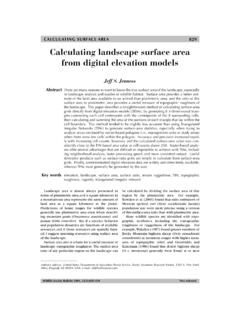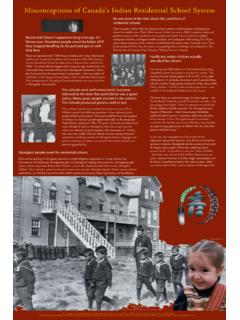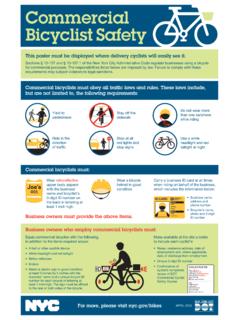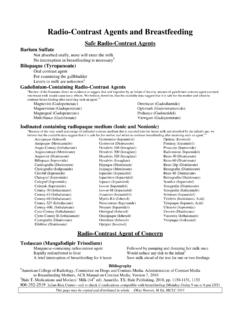Transcription of Topographic Position and Landforms Analysis The Nature ...
1 05101520kmsTopographic Position and Landforms AnalysisAndrew D. Weiss, The Nature ConservancyStudy AreaBasic AlgorithmSlope PositionLandformsWatershed MetricsBy thresholding the continuous TPI values at a given scale, and checking the slope for values near zero, landscapes can be classified into discrete slope Position classes (Fig. 3a).Using tpi300 (Fig. 3b), many individual ridge lines and valleys are delineated at a fine scale, including lateral drainages in the major valleys, and the bottoms of the major canyons are classified as flat areas. At tpi2000, the classification shows the major Landforms (Fig. 3c): mountains, major ridge lines, and the major valleys and canyons. Smaller lateral features disappear, and canyons bottoms are now classified as the thresholds needs to take into account several factors: the specific landscape (a ridge in Kansas is different than a ridge in central Colorado); the scale of the index; and the particular problem being addressed.
2 Selected features particularly important to a specific Analysis could be extracted by adjusting class breakpoints, and incorporating additional metrics, such as the variance of elevation or slope in the neighborhood of the target repeatable method of creating classes, used in Fig. 3b and 3c, is to use standard deviation units. In this example, classes 2 and 5 are de-emphasized:ClassDescription Breakpoints1ridge> + 1 STDEV2upper slope > STDV =< 1 STDV3middle slope > STDV, < STDV, slope > 5 deg4flats slope>= STDV, =< STDV , slope <= 5 deg5lower slopes>= STDEV, < STDV6valleys< STDVL andformscanyons, deeply incised streamsmidslope drainages, shallow valleysupland drainages, headwatersU-shape valleysplainsopen slopesupper slopes, mesaslocal ridges/hills in valleysmidslope ridges, small hills in plainsmt tops, high ridgesPositive(ridge)Negative(valley)0de pression valley bottomVery negative(valley)Very positive(ridge)Zero, low slope(flat)Negative(cliff base)Zero, high slope(open cliff)Positive(cliff edge)Zero, low slope(flat)Moderately positive(upper slope)Zero, moderate slope(open slope)Moderately negative(lower slope)
3 Hill topridge topcliffedgeupper slopeplainsconstant slopesaddleslowerslopecliffbaseMore positiveMore negative0gentlelateralvalleysgentlelater alridgesTP300s HUC metricmean value under - - - - - HUC metricmean value under - - - - - physical and biological processes acting on the landscape are highly correlated with Topographic Position : a hilltop, valley bottom, exposed ridge, flat plain, upper or lower slope, and so on. Examples of these processes include soil erosion and deposition; hydrological balance and response; wind exposure; and cold air drainage. These biophysical attributes in turn are key predictors of habitat suitability, community composition, and species distribution and poster presents an algorithm, implemented in GRID, for generating a multi-scale Topographic Position Index, classifying this index into slope Position and landform types, and using the Topographic Position Index to characterize watersheds.
4 This work was done as a contractor with EPA Region 10, working on the Environmental Monitoring and Asssessment Program Western Landscape Project (Jones et al2000).Jones, K. Bruce et al2000. Assessing Landscape Conditions Relative to Water Resources in the Western United States: A Strategic Approach. Environmental Monitoring and Assessment64: 227 Topographic Position Index (TPI) compares the elevation of each cell in a DEM to the mean elevation of a specified neighborhood around that cell (Fig. 2a). In this example an annulus neighborhood is used, but continuous circles or other shapes could be used. Since the only input required is a digital elevation model, TPI can be readily generated almost TPI values represent locations that are higher than the average of their surroundings, as defined by the neighborhood (ridges). Negative TPI values represent locations that are lower than their surroundings (valleys).
5 TPI values near zero are either flat areas (where the slope is near zero) or areas of constant slope (where the slope of the point is significantly greater than zero). Topographic Position is an inherently scale-dependent phenomenon. As an example, consider a location in a meadow in Yosemite valley. At a fine scale of 100m, the Topographic Position would be a flat plain. This may be an appropriate scale for looking at soil transport or site water balance. At a scale of several kilometers, this same point is at the bottom of a 1500m deep canyon, which may be more significant for overall hydrology, mesoclimate, wind exposure, or cold air drainage. The ecological characteristics of a site may be affected by TPI at several scales. In a study of vegetation distributions in the Spring Mountains of southern Nevada (Guisan, Weiss, and Weiss 1999) species distribution models show significant relationships to TPI at scales of 300m, 1000m, and 2000m.
6 TPI was generally second most important predictive variable after , A., S. B. Weiss, A. D. Weiss 1999. GLM versus CCA spatial modeling of plant species distribution. Plant Ecology143: 107-122 Watersheds can be characterized by extracting the TPI values underneath streams or within a buffer around streams, and then taking the mean value within each watershed unit. The example at right overlays streams from the Pacific Northwest River Reach Files over tpi2000, then computes the mean value within USGS 5thlevel Hydrologic Units. Watersheds with higher (more negative) mean values have a high proportion of streams that are in relatively deeper and narrower drainages, with narrowness defined by the spatial scale of the index. At the scale of 300m (fig. 5c), the metric reflects the degree that the stream channel is incised, and the narrowness of the valley. At the scale of 2000m (fig 5d) the metric reflects the broader valley morphology and the relative relief of streams and their surrounding topography.
7 This can be seen in the lower Willamette valley, where the tpi300 metric shows streams to be more incised (light blue) than further up the valley. At tpi2000 these same watersheds move into the lowest quintile. As the scale increases, HUCs in the middle Coast Range move from the top quintile (red) to the middle quintiles. This reflects the lower relief of the mountains in this area. In the southern Cascades, HUCs that were in the middle quintiles at 300m are in the top quintile at 2000m, which reflects the high degree of relief in this region, the wide valleys on the west slope of the Cascades, and the presence of several volcanic peaks on the east an indicator, which might expect that HUCs in the top quintiles at 300m to be more sensitive to near-stream deforestation, grazing, and human impacts. HUCs in the top quintiles at 2000m might be more sensitive to drainage wide deforestation and land use, and would likely have a stronger response to extreme weather and snowmelt < = tpi < 0 (valley)iradoradElevation at point ptpt > = tpi > 0 (ridge)tpi<scalefactor>= int((dem - focalmean(dem, annulus,irad, orad)) +.)
8 5)scalefactor = outer radius in map unitsirad = inner radius of annulus in cellsorad = outer radius of annulus in cellsThe index is converted to integer for storage efficiency and symbolizationMean Elevation neighborhood Elevation at point ptMean Elevation neighborhood Mean Elevation in Neighborhood Elevation at point ptMean Elevation in neighborhood Elevation at point ptpt ~ = tpi ~ 0 (constant slope, flat area, or saddle)Check slope of the pointSlopeFlatFig. 2a: Topographic Position IndexFig. 2b: tpi300, computed from a 30m DEM with the formula:tpi300 = int((dem focalmean(dem, annulus, 5, 10)) + )At this scale a dendridic network of both main and lateral ridgesand drainages are 2c: tpi2000, computed from a 30m DEM with the formula:tpi2000 = int((dem focalmean(dem, annulus, 62, 67)) + )At his scale the major ridge lines and drainages are lateral features 3a: TPI and slope positionFig.
9 3b tpi300 thresholded by standard deviation unitsinto 6 slope Position classes Fig. 3c tpi2000 thresholded by standard deviation unitsinto 6 slope Position classes Small scaletpi300 Large scale tpi2000LF = 6 Broad open slopes(slope > 0)LF = 5 Broad Flat Areas(slope = 0) Local ridges in plainsLocal valleys in plainsflat ridge topsmesa topsU-shape valleysHigh narrow ridgesmountain topsDeep narrow canyonsLocal ridge/hilltops within broad valleysUpland inciseddrainagesStream headwatersLateral midslopeincised drainagesLateral midslopedrainage dividesV-shape river valleysLF = 1LF = 2LF = 3LF = 7LF = 4LF = 8LF = 9LF = 11 Fig 4a: Combining TPI at 2 scales to develop landform classesFig 4b: The Mt. Hood region classified into 10 landform 5a: Streams (1:100k PNW Reach files) overlaid on tpi2000, with USGS Level 5 Hydrologic Unit boundariesFig. 5b: Topography of the Western EMAP Oregon Pilot Area, with 5thlevel 5c: Watershed Metrics for tpi300,Quintile classificationFig.
10 5d: Watershed Metrics for tpi300,Quintile classificationCombining TPI at a small and large scale allows a variety of nested Landforms to be distinguished (fig. 4a). As a general rule, because elevation tends to be spatially autocorrelated, the range of TPI values increases with scale. One method to address this problem is to standardize the TPI grids to mean = 0 and stdev = 1 (this should only be done if the means of the original TPI grids are reasonably close to zero). This lets the same basic equations to be used to classify any scale combinations of TPI exact breakpoints among classes can be manually chosen to optimize the classification for a particular landscape and problem. As in slope Position classifications, additional Topographic metrics, such as variances of elevation, slope, or aspect within the neighborhoods, may help delineate Landforms more accurately, and extract different types of * First, standardize the TPI grids using the formula:/* tpi<sf>_stdi = int((((tpi<sf> mean) / stdv) * 100) + )tp300_stdi = int((((tp300i - ) / ) * 100) +.)










